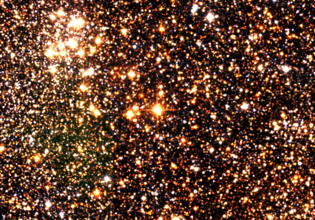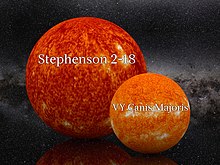Stephenson 2-18
Stephenson 2-18 (St2-18), also known as Stephenson 2-DFK 1, or RSGC2-18, is a red supergiant (RSG) star within the open cluster Stephenson 2 located around 6,000 parsecs (20,000 ly) away from Earth in the constellation of Scutum. It is among the largest known stars and one of most luminous red supergiants, with an estimated radius around 2,150 times that of the Sun (R☉), which corresponds to a volume around 10 billion times bigger than the Sun. If placed at the center of the Solar System, its photosphere would engulf the orbit of Saturn.
 Dense starfield around the red supergiant star St2-18 (brightest star in the image) as seen from the 2MASS astronomical survey. The picture was published in 2003. Credit: Université de Strasbourg/CNRS | |
| Observation data Epoch J2000 Equinox J2000 | |
|---|---|
| Constellation | Scutum |
| Right ascension | 18h 39m 02.3709s[1] |
| Declination | −06° 05′ 10.5357″[1] |
| Characteristics | |
| Evolutionary stage | Red supergiant |
| Spectral type | M |
| Apparent magnitude (G) | 15.2631±0.0092[1] |
| Apparent magnitude (J) | 7.150 |
| Apparent magnitude (H) | 4.698 |
| Apparent magnitude (K) | 2.9 |
| Astrometry | |
| Proper motion (μ) | RA: −3.045±0.511[1] mas/yr Dec.: −5.950±0.480[1] mas/yr |
| Parallax (π) | −0.0081 ± 0.3120[1] mas |
| Distance | 19,560[2] ly (6,000[2] pc) |
| Details | |
| Radius | 2,150[3] R☉ |
| Luminosity | 90,000[4]–440,000[3] L☉ |
| Temperature | 3,200[3] K |
| Other designations | |
| Database references | |
| SIMBAD | data |
Observation history

The open cluster Stephenson 2 was discovered by American astronomer Charles Bruce Stephenson in 1990 in the data obtained by a deep infrared survey.[2][5]
The brightest star in the region of the cluster was given the number 1 in the first analysis of cluster member properties. However, it was not considered to be a member of Stephenson 2 due to its outlying position, abnormally high brightness, and slightly atypical proper motion.[2] In a later study, the same star was given the number 18 and assigned to an outlying group of stars called Stephenson 2 SW, assumed to be at the same distance as the core cluster.[4]
Physical properties
St 2-18 shows the traits and properties of a red supergiant. This implies its position on the Hertzsprung–Russell diagram, occupying the top right corner. St 2-18 is possibly near the limit of the luminosity that can be obtained by a red supergiant.[4][6]
A calculation of the bolometric luminosity by fitting the Spectral Energy Distribution (SED) gives the star a luminosity of nearly 440,000 L☉, with an effective temperature of 3,200 K, which corresponds to a very large but extreme radius of 2,150 R☉ (1.50×109 km; 10.0 au; 930,000,000 mi), which would be considerably larger, cooler and more luminous than theoretical models of the largest, coolest, and most luminous possible red supergiants (roughly 1,500 R☉, 3,450 - 3,715 K, and 320,000 L☉).[7][3] An alternate but older calculation from 2010 gives a much lower and relatively modest luminosity of 90,000 L☉.[4]
Stage in life
Based on current stellar models and theories on stellar evolution, St 2-18 has the potential to evolve into a yellow hypergiant, and then into a luminous blue variable or Wolf–Rayet star, at which stage its outer layers will be stripped off by strong stellar winds. Eventually, St 2-18 will begin to fuse iron, when it will undergo type IIb, IIn, or type Ib/Ic supernova, and judging by its extreme physical parameters, leave behind a black hole, not a neutron star.
See also
References
- Brown, A. G. A.; et al. (Gaia collaboration) (August 2018). "Gaia Data Release 2: Summary of the contents and survey properties". Astronomy & Astrophysics. 616. A1. arXiv:1804.09365. Bibcode:2018A&A...616A...1G. doi:10.1051/0004-6361/201833051. Gaia DR2 record for this source at VizieR.
- Davies, B.; Figer, D. F.; Kudritzki, R. P.; MacKenty, J.; Najarro, F.; Herrero, A. (2007). "A Massive Cluster of Red Supergiants at the Base of the Scutum‐Crux Arm". The Astrophysical Journal. 671 (1): 781–801. arXiv:0708.0821. Bibcode:2007ApJ...671..781D. doi:10.1086/522224. S2CID 1447781.
- Fok, Thomas K. T; Nakashima, Jun-ichi; Yung, Bosco H. K; Hsia, Chih-Hao; Deguchi, Shuji (2012). "Maser Observations of Westerlund 1 and Comprehensive Considerations on Maser Properties of Red Supergiants Associated with Massive Clusters". The Astrophysical Journal. 760 (1): 65. arXiv:1209.6427. Bibcode:2012ApJ...760...65F. doi:10.1088/0004-637X/760/1/65. S2CID 53393926.
- Deguchi, Shuji; Nakashima, Jun-Ichi; Zhang, Yong; Chong, Selina S. N.; Koike, Kazutaka; Kwok, Sun (2010). "SiO and H2O Maser Observations of Red Supergiants in Star Clusters Embedded in the Galactic Disk". Publications of the Astronomical Society of Japan. 62 (2): 391–407. arXiv:1002.2492. Bibcode:2010PASJ...62..391D. doi:10.1093/pasj/62.2.391. S2CID 24396370.
- Stephenson, C. B. (1990). "A possible new and very remote galactic cluster". The Astronomical Journal. 99: 1867. Bibcode:1990AJ.....99.1867S. doi:10.1086/115464.
- van Marle, A. J.; Owocki, S. P.; Shaviv, N. J. (2008). "Continuum‐Driven Winds from Super‐Eddington Stars: A Tale of Two Limits". First Stars III. AIP Conference Proceedings. Santa Fe (New Mexico). 990: 250–253. arXiv:0708.4207. Bibcode:2008AIPC..990..250V. doi:10.1063/1.2905555. S2CID 118364586.
- Emily M. Levesque; Philip Massey; K. A. G. Olsen; Bertrand Plez; et al. (August 2005). "The Effective Temperature Scale of Galactic Red Supergiants: Cool, but Not As Cool As We Thought". The Astrophysical Journal. 628 (2): 973–985. arXiv:astro-ph/0504337. Bibcode:2005ApJ...628..973L. doi:10.1086/430901. S2CID 15109583.